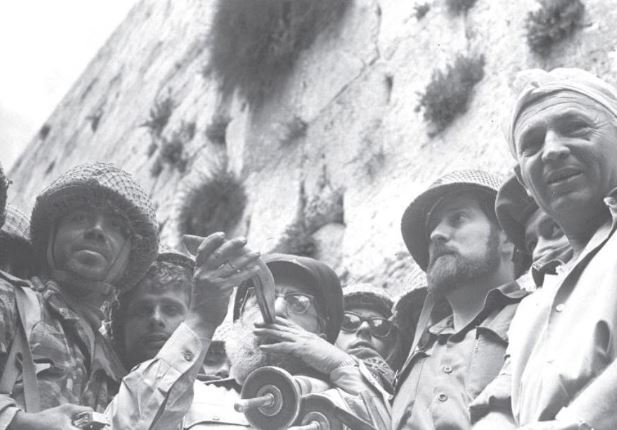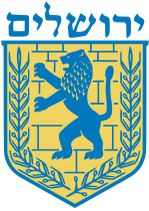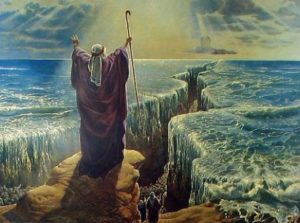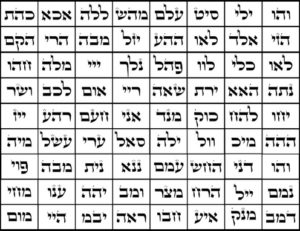Tonight, we usher in Yom Yerushalayim, Jerusalem Day, commemorating the liberation of Jerusalem on the 28th of Iyar, 5727 (June 7, 1967) during the Six-Day War. As explored in depth before, Yom Yerushalayim happens to be on the day of Sefirat haOmer that corresponds to Chessed sh’b’Malkhut, literally “Kindness in Kingdom”. It is the first day, and first step, of the Malkhut week. In the same way, the liberation of Jerusalem on that day in 1967 was the first step towards re-establishing the ultimate Malkhut, God’s Kingdom, here on Earth, and restoring Malkhut David, the Kingdom of David in Israel. After all, it is King David who first established Jerusalem as Israel’s eternal capital. The aspect of Chessed on this day was that Yom Yerushalayim—and the entire miraculous Six-Day War in general—was a clear display of God’s Kindness. More amazing still, the Zohar seems to have exactly predicted this day many centuries earlier.

IDF Paratroopers that liberated Jerusalem, with Rabbi Shlomo Goren holding a Torah scroll, at the Western Wall on June 7, 1967.
In Zohar Chadash on parashat Balak, the Zohar comments on the End of Days prophecy of Bilaam. Recall that the gentile prophet Bilaam was hired by King Balak of Moab to curse Israel, but instead ended up blessing Israel. Within his blessing, he gave a prophecy of Acharit haYamim, the “End of Days” (Numbers 24:14, one of four places in the Torah where Acharit haYamim is mentioned). One of the things that Bilaam predicted was that in the far future (“I see it, but not now…”) the princes of Moab would be subdued. The Zohar Chadash expounds upon this verse and says:
In the End of Days, (according to the metaphorical “days”) when the sun will rise in the “Sixth Day”, when the cycle of years will work out in such a way that the Sabbatical and Jubilee will come together, which will happen 274 years [before the end] of the “Sixth Day”, a sound will go forth to arouse the great heights of the heavens…
The Zohar goes on to describe in detail the events that will happen in those final years, the “birth pangs of the Messiah”, culminating in the coming of Mashiach and his subsequent kingship. The Zohar employs the famous notion that each day of Creation corresponds to a millennium of civilization. Civilization as we know it is meant to last for 6000 years. The Messianic Age must come before the end of the sixth millennium, ie. the cosmic “Sixth Day”, to usher in the final Cosmic Shabbat millennium. The Zohar says that 274 years before the end of the Sixth Day there will be a Sabbatical Shemittah year, followed by a Jubilee (the 50th year of the Sabbatical cycle). So, if we count 274 years from the end of 6000, we get to the Jewish year 5726, or 1966. That year was indeed observed as a Sabbatical year in Israel. The following year, 5727 (corresponding to the end of 1966 and most of 1967), would have been a Jubilee. We also know that the Messianic Age is meant to begin after the conclusion of a Sabbatical year (as stated in multiple places in Midrash and Talmud, such as Sanhedrin 97a). Thus, it seems the Zohar posited long ago that the “Footsteps of the Messiah” period would begin in 1967.
This fits perfectly with what actually happened in 1967, when Israel miraculously routed all of its enemies in a mere six days (which, I think, is further symbolic of this Zohar prophecy that repeatedly speaks of the “Sixth Day” over and over again). More significantly, after two millennia, the Jewish people were once more in control of their holiest city and eternal capital, as well as the surrounding Biblical heartland of Judea and Samaria. Recall that Israel recaptured Jerusalem and the “West Bank” from the Jordanians. Jordan lies on the ancient territory of Moab, and the Zohar specifically gives this prophecy in its discourse on the verse that says the princes of Moab would be subdued!

Rabbi Shlomo Goren blows the shofar by the Western Wall during the 1967 liberation of Jerusalem.
Finally, we can deduce from the Zohar that 1967 was a Jubilee year. The Torah states that in a Jubilee year, a shofar should be blown and “freedom should be proclaimed in all the land…” (Leviticus 25:10) This makes Rabbi Shlomo Goren’s blowing of the shofar at the Western Wall during the liberation of Jerusalem even more significant. It may very well be that the recapture and reunification of Jerusalem in 1967 formally began the pre-Messianic Age, and we are undoubtedly nearing the fulfilment of the rest of the incredible prophecies, too.
Happy Jerusalem Day!
*Postscript: Since first publishing this article, there have been some requests at clarification of the Zohar chronology. The exact language of the Zohar is רע”ד מן יומא שתיתאה, meaning “274 years from the sixth day”. Some interpret it to mean 274 years into the sixth day, meaning the year 5274. However, that year was not a shemittah year, so it cannot be the meaning of the Zohar. We have to say the Zohar means 274 years from the end of the sixth day, meaning 5726, and that year was indeed a shemittah. (Besides, the passage begins by saying this will happen at the End of Days, so we would expect a year closer to the final 6000.) Some have pointed out that certain commentaries say there is an alternate version of this Zohar that says 384 years, not 274, but using 384 is even more problematic since we do not get a shemittah year either counting from the start or from the end of the sixth day! I believe the only possible accurate reading is indeed “274 years from the end of the sixth day”.


 In this week’s parasha, Va’era, we read about the first seven plagues to strike Egypt. These were brought about through the Staff of Moses, as were the later Splitting of the Sea, the victory over Amalek (Exodus 17) and the water brought forth from a rock. What was so special about this particular staff, and what was the source of its power?
In this week’s parasha, Va’era, we read about the first seven plagues to strike Egypt. These were brought about through the Staff of Moses, as were the later Splitting of the Sea, the victory over Amalek (Exodus 17) and the water brought forth from a rock. What was so special about this particular staff, and what was the source of its power?
